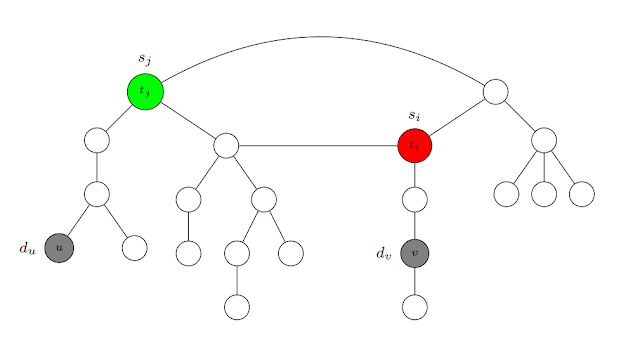淺談多項式除法 Part 1: 快速演算法
計算兩個不超過 $n$ 次的複係數一元多項式 $f(x)$ 和 $g(x)$ 的乘積,可以藉由 FFT (Fast Fourier Transform, 快速傅立葉變換) 在 $O(n\log n)$ 時間內求得。更一般的情形,設 $R$ 為一個環且 $f(x), g(x) \in R[x]$,則 $f(x)g(x)$ 可以用 Karatsuba 演算法在 $O(n^{\log_23})$ 時間內求得,也比 naïve 演算法的 $O(n^2)$ 快。假設多項式乘法的時間複雜度是 $O(M(n))$,這篇將介紹如何在 $O(M(n))$ 時間內計算 $f(x)\div g(x)$ 的商式和餘式。
先定義好我們的問題:設 $R$ 為一個有 $1$ 的環,$f(x), g(x) \in R[x]$ 滿足
先定義好我們的問題:設 $R$ 為一個有 $1$ 的環,$f(x), g(x) \in R[x]$ 滿足
- $\deg f = n$
- $g(x) \neq 0, \deg g = m \leq n$
- $g$ 的 $x^m$ 項係數為 $1$
- $f(x) = q(x)g(x) + r(x)$
- $\deg r < m$
\[(\mathscr{R}h)(x) = \begin{cases}0,&\text{if }h(x) = 0,\\x^ph(\frac{1}{x}),&\text{if }\deg h = p.\end{cases}\]
事實上,若 $h(x) = \alpha_0 + \sum_{i=1}^p\alpha_ix^i \neq 0$,則 $(\mathscr{R}h)(x) = \alpha_p+\sum_{i=1}^p\alpha_{p-i}x^i$。這樣一來,就有
\[(\mathscr{R}f)(x) = \begin{cases}(\mathscr{R}q)(x)\cdot(\mathscr{R}g)(x),&\text{if }r(x) = 0,\\(\mathscr{R}q)(x)\cdot(\mathscr{R}g)(x)+x^{n-\deg r}(\mathscr{R}r)(x),&\text{otherwise}.\end{cases}\]
注意當 $r(x) \neq 0$ 時,有 $n-\deg r \geq n-m+1$。所以我們總是有
\[(\mathscr{R}f)(x) \operatorname{mod}x^{n-m+1} = ((\mathscr{R}q)(x)\cdot(\mathscr{R}g)(x)) \operatorname{mod}x^{n-m+1}\]
如果我們能找到 $(\mathscr{R}g)(x)^{-1} \operatorname{mod}x^{n-m+1}$,就有
\[(\mathscr{R}q)(x) \operatorname{mod}x^{n-m+1} = ((\mathscr{R}f)(x)\cdot(\mathscr{R}g)(x)^{-1}) \operatorname{mod}x^{n-m+1}\]
又因為 $\deg q = n-m$,事實上我們有 $(\mathscr{R}q)(x) \operatorname{mod}x^{n-m+1} = (\mathscr{R}q)(x)$,因此上式可以改成
\[(\mathscr{R}q)(x) = ((\mathscr{R}f)(x)\cdot(\mathscr{R}g)(x)^{-1}) \operatorname{mod}x^{n-m+1}\]
一旦求得了 $(\mathscr{R}g)(x)^{-1} \operatorname{mod}x^{n-m+1}$,就能在 $O(M(n))$ 時間內計算出 $q(x)$ 以及 $r(x) = f(x) - q(x)g(x)$。接下來我們把目標放在:給定 $h \in R[x]$ 和 $k \in \mathbb{Z}_{\geq 1}$,其中 $h$ 的常數項為 $1$,求出 $h^{-1}\operatorname{mod}x^k$。
不難發現 $h^{-1}\operatorname{mod}x = 1$。令 $l \in \mathbb{Z}_{\geq 1}$ 並假設 $s := h^{-1} \operatorname{mod} x^l$ 為已知,我們介紹一個在 $O(M(l))$ 時間內求出 $h^{-1}\operatorname{mod}x^{2l}$ 的演算法。
令 $h(x) = h_0 + h_1x^l + (\text{higher terms})$,其中 $h_0, h_1 \in R[x]$ 且 $\deg h_0, \deg h_1 \leq l-1$。我們想找某個 $a, b \in R[x]$,其中 $\deg a, \deg b \leq l-1$,使得 \begin{equation}\label{eq1}(a+bx^l)h\operatorname{mod}x^{2l} = (a+bx^l)(h_0+h_1x^l)\operatorname{mod}x^{2l} = (ah_0 + (ah_1+bh_0)x^l)\operatorname{mod}x^{2l} = 1\end{equation} 注意 \[(a+bx^l)h\operatorname{mod}x^l = ((a+bx^l)h\operatorname{mod}x^{2l})\operatorname{mod}x^l = ah_0\operatorname{mod}x^l = ah\operatorname{mod}x^l=1\] 所以 $a = s$。接著,令 $ah_0 = sh_0 = 1 + cx^l$,其中 $c \in R[x]$,則 $(\ref{eq1})$可以改寫成 \[(1 + (sh_1+bh_0+c)x^l)\operatorname{mod}x^{2l} = 1\] 因此 $sh_1+bh_0+c=0\operatorname{mod}x^l$,亦即 $b = -s(sh_1+c)\operatorname{mod}x^l$,此時的 $a+bx^l$ 就是 $h^{-1}\operatorname{mod}x^{2l}$。因為 $s, h_0, h_1, c$ 的次數都不超過 $l-1$,由 $h^{-1}\operatorname{mod}x^l$ 計算 $h^{-1}\operatorname{mod}x^{2l}$ 的時間複雜度是 $O(M(l))$。
最後,假設計算 $h^{-1}\operatorname{mod}x^k$ 的總時間為 $T(k)$,利用這個倍增法,可知 $T(k) = T(\lceil\frac{k}{2}\rceil)+O(M(k)) = O(M(k))$,也就是計算 $q(x)$ 和 $r(x)$ 只需要 $O(M(n))$ 時間,和乘法一樣。
我是在這裡學到這個演算法的。至於實作部分,有興趣的話可以參考我放在github上的整係數多項式模板。
不難發現 $h^{-1}\operatorname{mod}x = 1$。令 $l \in \mathbb{Z}_{\geq 1}$ 並假設 $s := h^{-1} \operatorname{mod} x^l$ 為已知,我們介紹一個在 $O(M(l))$ 時間內求出 $h^{-1}\operatorname{mod}x^{2l}$ 的演算法。
令 $h(x) = h_0 + h_1x^l + (\text{higher terms})$,其中 $h_0, h_1 \in R[x]$ 且 $\deg h_0, \deg h_1 \leq l-1$。我們想找某個 $a, b \in R[x]$,其中 $\deg a, \deg b \leq l-1$,使得 \begin{equation}\label{eq1}(a+bx^l)h\operatorname{mod}x^{2l} = (a+bx^l)(h_0+h_1x^l)\operatorname{mod}x^{2l} = (ah_0 + (ah_1+bh_0)x^l)\operatorname{mod}x^{2l} = 1\end{equation} 注意 \[(a+bx^l)h\operatorname{mod}x^l = ((a+bx^l)h\operatorname{mod}x^{2l})\operatorname{mod}x^l = ah_0\operatorname{mod}x^l = ah\operatorname{mod}x^l=1\] 所以 $a = s$。接著,令 $ah_0 = sh_0 = 1 + cx^l$,其中 $c \in R[x]$,則 $(\ref{eq1})$可以改寫成 \[(1 + (sh_1+bh_0+c)x^l)\operatorname{mod}x^{2l} = 1\] 因此 $sh_1+bh_0+c=0\operatorname{mod}x^l$,亦即 $b = -s(sh_1+c)\operatorname{mod}x^l$,此時的 $a+bx^l$ 就是 $h^{-1}\operatorname{mod}x^{2l}$。因為 $s, h_0, h_1, c$ 的次數都不超過 $l-1$,由 $h^{-1}\operatorname{mod}x^l$ 計算 $h^{-1}\operatorname{mod}x^{2l}$ 的時間複雜度是 $O(M(l))$。
最後,假設計算 $h^{-1}\operatorname{mod}x^k$ 的總時間為 $T(k)$,利用這個倍增法,可知 $T(k) = T(\lceil\frac{k}{2}\rceil)+O(M(k)) = O(M(k))$,也就是計算 $q(x)$ 和 $r(x)$ 只需要 $O(M(n))$ 時間,和乘法一樣。
我是在這裡學到這個演算法的。至於實作部分,有興趣的話可以參考我放在github上的整係數多項式模板。

留言
張貼留言